Experimental Investigation on the Effects of Direct Injection Timing on the Combustion, Performance and Emission Characteristics of Methanol/Gasoline Dual-Fuel Spark Turbocharged Ignition (DFSI) Engine with Different Injection Pressures under High Load
Abstract
:1. Introduction
2. Experimental Apparatus and Procedure
2.1. Test Engine and Fuel
2.2. Experimental Instrumentation
2.3. Experimental Procedure
3. Results and Discussion
3.1. Effect of Injection Timing on Combustion Characteristics
3.2. Effect of Injection Timing on Performance Characteristics
3.3. Effect of Injection Timing on Emission Characteristics
4. Conclusions
Author Contributions
Funding
Data Availability Statement
Conflicts of Interest
Nomenclature
| CA | crank angle |
| ATDC | after top dead center |
| EGT | exhaust gas temperature |
| BTE | brake thermal efficiency |
| ICE | internal combustion engines |
| ISFC | indicated specific fuel consumption |
| CR | compression ratio |
| ECU | electronic control unit |
| HRR | heat release rate |
| COV | coefficient of variation |
| IMEP | indicated mean effective pressure |
| PB | brake power |
| MF | mass flow |
| LHV | lower heating values |
| Pmax | maximum in-cylinder pressure |
| APmax | maximum in-cylinder pressure corresponding phase |
| HRRmax | maximum heat release rate |
| AHRRmax | maximum heat release rate corresponding phase |
| BDC | bottom dead center |
| CO | carbon monoxide |
| HC | hydrocarbon |
| NOx | nitrogen oxide |
References
- Su, Y.; Zhang, Y.; Xie, F.; Duan, J.; Li, X.; Liu, Y. Influence of ethanol blending ratios on in-cylinder soot processes and particulate matter emissions in an optical direct injection spark ignition engine. Fuel 2022, 308, 121944. [Google Scholar] [CrossRef]
- Ravi, S.S.; Brace, C.; Larkin, C.; Aziz, M.; Leach, F.; Turner, J.W. On the pursuit of emissions-free clean mobility—Electric vehicles versus e-fuels. Sci. Total Environ. 2023, 875, 162688. [Google Scholar] [CrossRef]
- Liu, H.; Wang, Z.; Qi, Y.; He, X.; Wang, Y.; Wang, J. Super-knock suppression for highly turbocharged spark ignition engines using the fuel of propane or methanol. Energy 2019, 169, 1112–1118. [Google Scholar] [CrossRef]
- Verhelst, S.; Wallner, T. Hydrogen-fueled internal combustion engines. Prog. Energy Combust. Sci. 2009, 35, 490–527. [Google Scholar] [CrossRef]
- Franken, T.; Seidel, L.; Matrisciano, A.; Mauss, F.; Kulzer, A.C.; Schuerg, F. Analysis of the Water Addition Efficiency on Knock Suppression for Different Octane Ratings. SAE Int. J. Adv. Curr. Pract. Mobil. 2020, 2, 2531–2552. [Google Scholar] [CrossRef]
- Verhelst, S.; Turner, J.W.; Sileghem, L.; Vancoillie, J. Methanol as a fuel for internal combustion engines. Prog. Energy Combust. Sci. 2019, 70, 43–88. [Google Scholar] [CrossRef]
- Gong, C.; Liu, F.; Sun, J.; Wang, K. Effect of compression ratio on performance and emissions of a stratified-charge DISI (direct injection spark ignition) methanol engine. Energy 2016, 96, 166–175. [Google Scholar] [CrossRef]
- Yin, X.; Xu, L.; Duan, H.; Wang, Y.; Wang, X.; Zeng, K.; Wang, Y. In-depth comparison of methanol port and direct injection strategies in a methanol/diesel dual fuel engine. Fuel Process. Technol. 2023, 241, 107607. [Google Scholar] [CrossRef]
- Zhao, L.; Wang, D.; Qi, W. Particulate matter (PM) emissions and performance of bio-butanol-methanol-gasoline blends coupled with air dilution in SI engines. J. Aerosol Sci. 2020, 145, 105546. [Google Scholar] [CrossRef]
- Breda, S.; Berni, F.; d’Adamo, A.; Testa, F.; Severi, E.; Cantore, G. Effects on Knock Intensity and Specific Fuel Consumption of Port Water/Methanol Injection in a Turbocharged GDI Engine: Comparative Analysis. Energy Procedia 2015, 82, 96–102. [Google Scholar] [CrossRef]
- Miganakallu, N.; Yang, Z.; Rogóż, R.; Kapusta, Ł.J.; Christensen, C.; Barros, S.; Naber, J. Effect of water-methanol blends on engine performance at borderline knock conditions in gasoline direct injection engines. Appl. Energy 2020, 264, 114750. [Google Scholar] [CrossRef]
- Burke, U.; Metcalfe, W.K.; Burke, S.M.; Heufer, K.A.; Dagaut, P.; Curran, H.J. A detailed chemical kinetic modeling, ignition delay time and jet-stirred reactor study of methanol oxidation. Combust. Flame 2016, 165, 125–136. [Google Scholar] [CrossRef]
- Yates, A.; Bell, A.; Swarts, A. Insights relating to the autoignition characteristics of alcohol fuels. Fuel 2010, 89, 83–93. [Google Scholar] [CrossRef]
- Dziubak, T.; Karczewski, M. Experimental Study of the Effect of Air Filter Pressure Drop on Internal Combustion Engine Performance. Energies 2022, 15, 3285. [Google Scholar] [CrossRef]
- Karczewski, M.; Chojnowski, J.; Szamrej, G. A Review of Low-CO2 Emission Fuels for a Dual-Fuel RCCI Engine. Energies 2021, 14, 5067. [Google Scholar] [CrossRef]
- Shen, B.; Su, Y.; Yu, H.; Zhang, Y.; Lang, M.; Yang, H. Experimental study on the effect of injection strategies on the combustion and emissions characteristic of gasoline/methanol dual-fuel turbocharged engine under high load. Energy 2023, 282, 128925. [Google Scholar] [CrossRef]
- Guo, Z.; Yu, X.; Du, Y.; Wang, T. Comparative study on combustion and emissions of SI engine with gasoline port injection plus acetone-butanol-ethanol (ABE), isopropanol-butanol-ethanol (IBE) or butanol direct injection. Fuel 2022, 316, 123363. [Google Scholar] [CrossRef]
- Wang, B.; Xie, F.; Hong, W.; Du, J.; Chen, H.; Su, Y. The effect of structural parameters of pre-chamber with turbulent jet ignition system on combustion characteristics of methanol-air pre-mixture. Energy Convers. Manag. 2022, 274, 116473. [Google Scholar] [CrossRef]
- Karczewski, M.; Szamrej, G. Experimental Evaluation of the Effect of Replacing Diesel Fuel by CNG on the Emission of Harmful Exhaust Gas Components and Emission Changes in a Dual-Fuel Engine. Energies 2023, 16, 475. [Google Scholar] [CrossRef]
- Shang, W.; Yu, X.; Shi, W.; Xing, X.; Guo, Z.; Du, Y.; Liu, H.; Wang, S. Effect of exhaust gas recirculation and hydrogen direct injection on combustion and emission characteristics of a n-butanol SI engine. Int. J. Hydrogen Energy 2020, 45, 17961–17974. [Google Scholar] [CrossRef]
- Yu, X.; Guo, Z.; He, L.; Dong, W.; Sun, P.; Shi, W.; Du, Y.; He, F. Effect of gasoline/n-butanol blends on gaseous and particle emissions from an SI direct injection engine. Fuel 2018, 229, 1–10. [Google Scholar] [CrossRef]
- Wei, H.; Hua, J.; Pan, M.; Feng, D.; Zhou, L.; Pan, J. Experimental investigation on knocking combustion characteristics of gasoline compression ignition engine. Energy 2018, 143, 624–633. [Google Scholar] [CrossRef]
- Li, D.; Yu, X.; Guo, Z.; Zhang, J.; Wang, T.; Li, Y. Effects of isopropanol ratio at different excess air ratios on combustion and emissions characteristics of an isopropanol/gasoline dual-fuel combined injection SI engine. Fuel 2023, 333, 126507. [Google Scholar] [CrossRef]
- Guo, Z.; Yu, X.; Dong, W.; Sun, P.; Shi, W.; Du, Y.; Shang, Z.; Zhao, Z.; Li, D.; Wang, T. Research on the combustion and emissions of an SI engine with acetone-butanol-ethanol (ABE) port injection plus gasoline direct injection. Fuel 2020, 267, 117311. [Google Scholar] [CrossRef]
- Sarıkoç, S. Effect of H2 addition to methanol-gasoline blend on an SI engine at various lambda values and engine loads: A case of performance, combustion, and emission characteristics. Fuel 2021, 297, 120732. [Google Scholar] [CrossRef]
- Chaimanatsakun, A.; Sawatmongkhon, B.; Sittichompoo, S.; Theinnoi, K. Effects of reformed exhaust gas recirculation (REGR) of ethanol-gasoline fuel blends on the combustion and emissions of gasoline direct injection (GDI) engine. Fuel 2024, 355, 129506. [Google Scholar] [CrossRef]
- Valera, H.; Kumar, D.; Agarwal, A.K. Evaluating the effect of variable methanol injection timings in a novel co-axial fuel injection system equipped locomotive engine. J. Clean. Prod. 2022, 349, 131452. [Google Scholar] [CrossRef]
- Sahu, S.; Kumar, P.; Dhar, A. Effect of injection timing on combustion, performance and emissions characteristics of methanol fuelled DISI engine: A numerical study. Fuel 2022, 322, 124167. [Google Scholar] [CrossRef]
- Jiang, Y.; Chen, Y.; Xie, M. Effects of blending dissociated methanol gas with the fuel in gasoline engine. Energy 2022, 247, 123494. [Google Scholar] [CrossRef]
- Osman, A.I. Mass spectrometry study of lignocellulosic biomass combustion and pyrolysis with NOx removal. Renew. Energy 2020, 146, 484–496. [Google Scholar] [CrossRef]

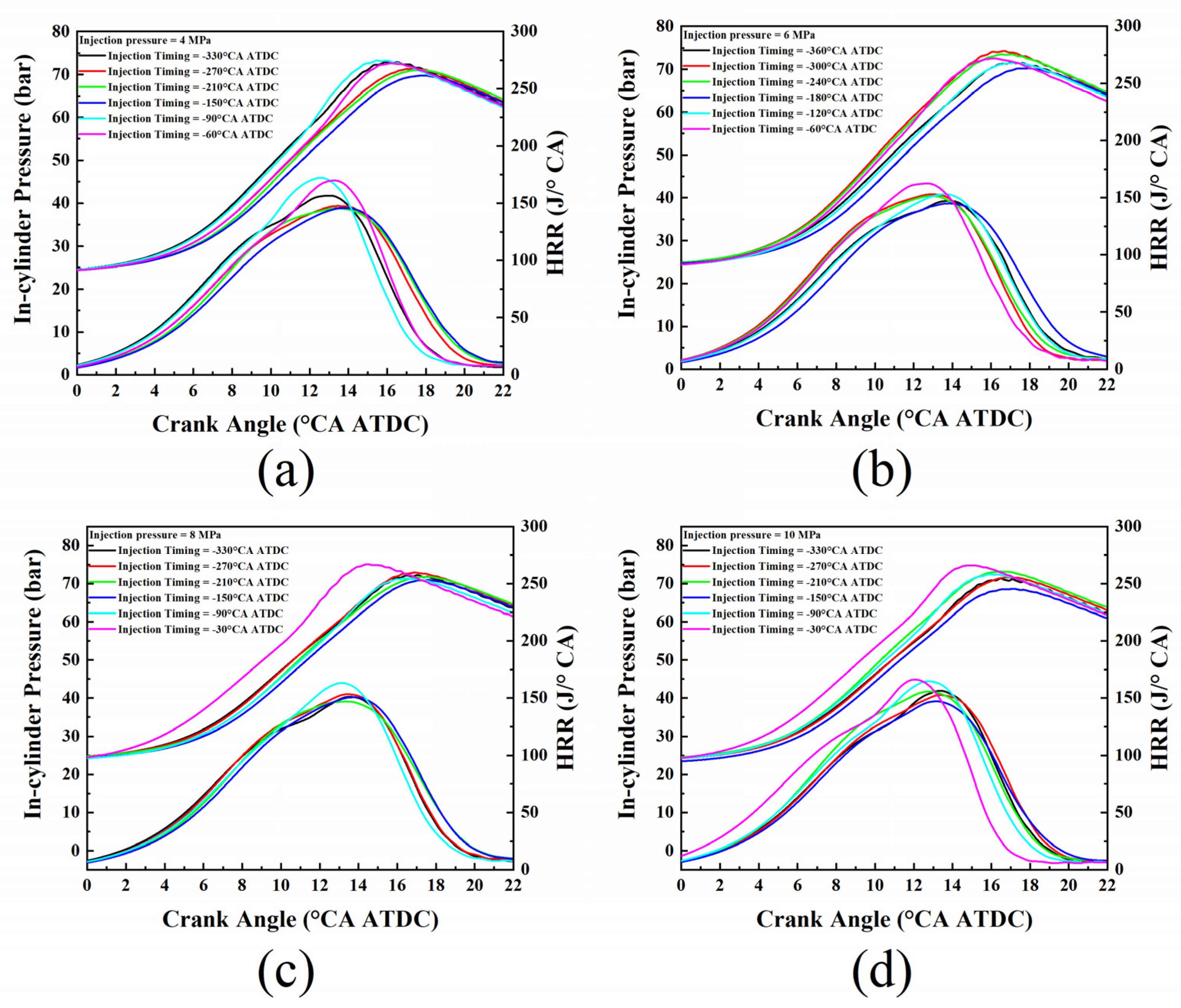

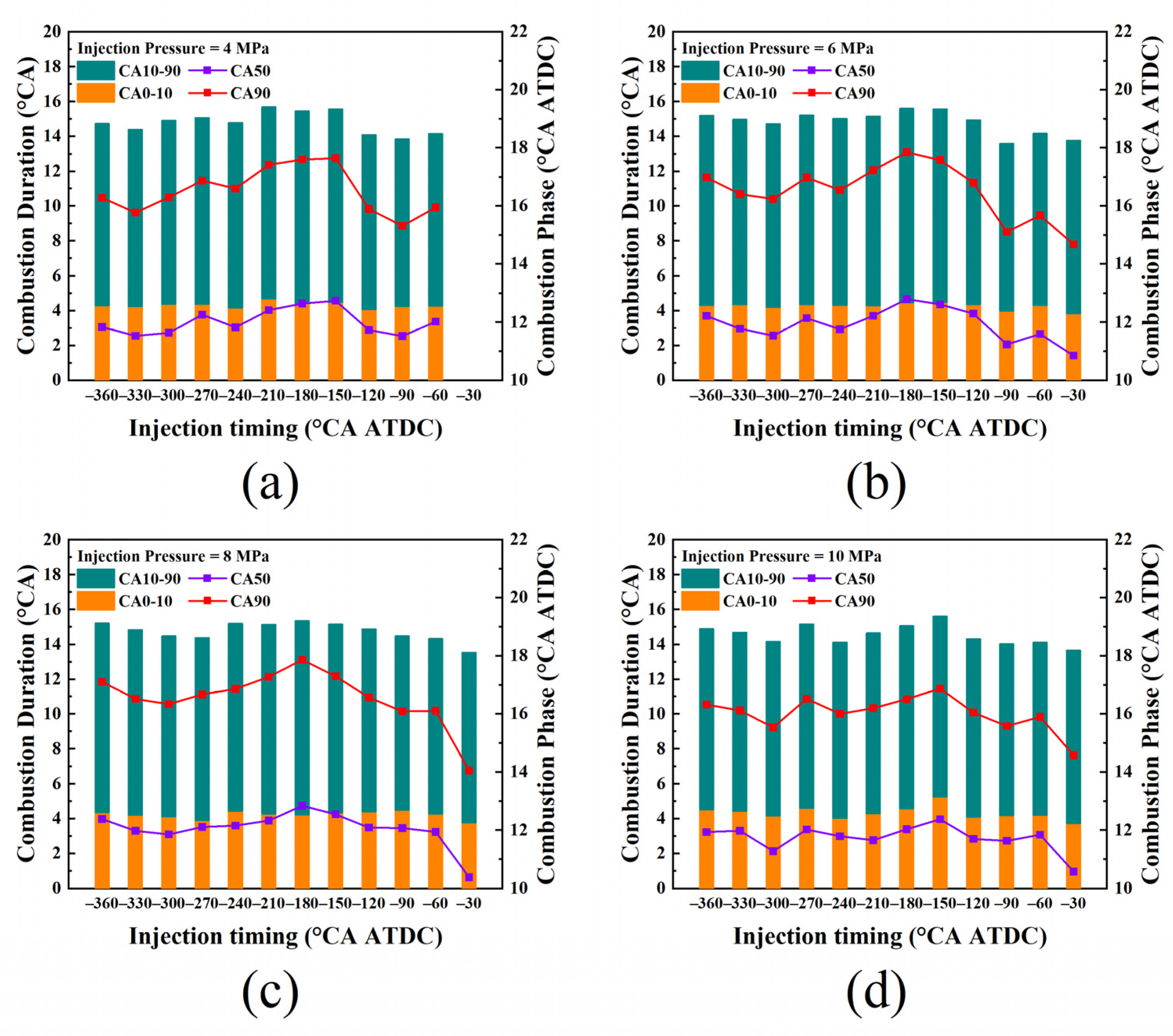
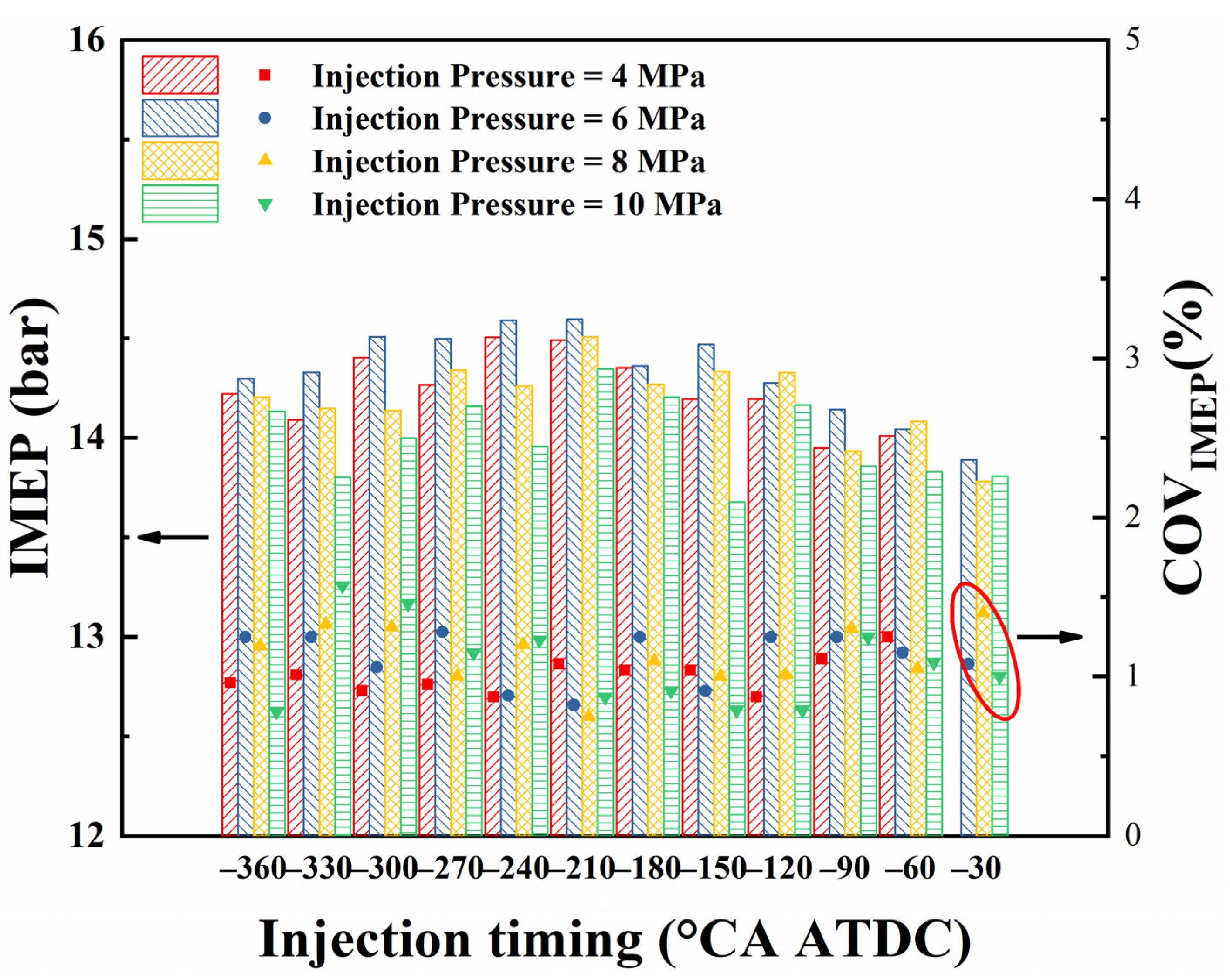
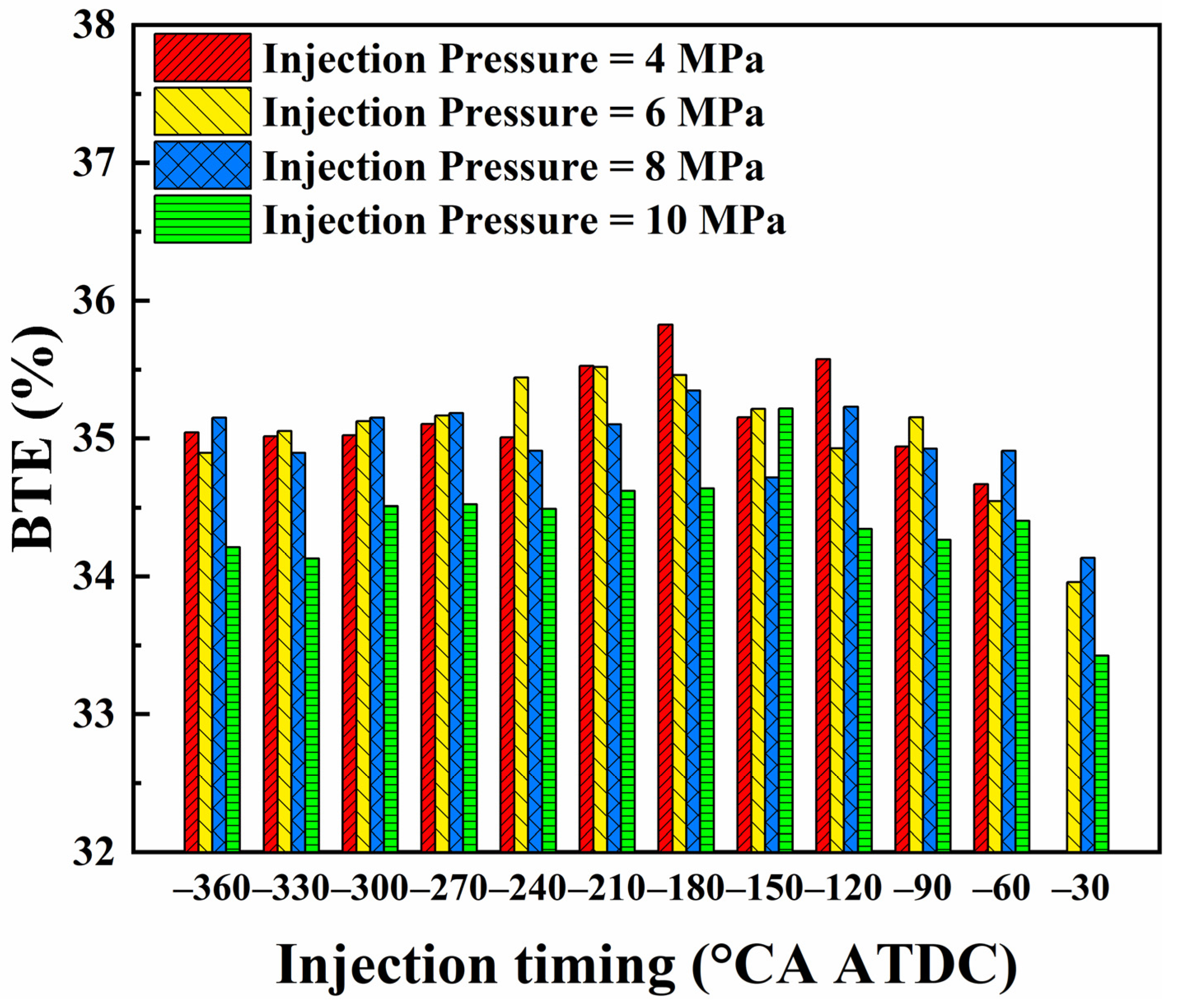

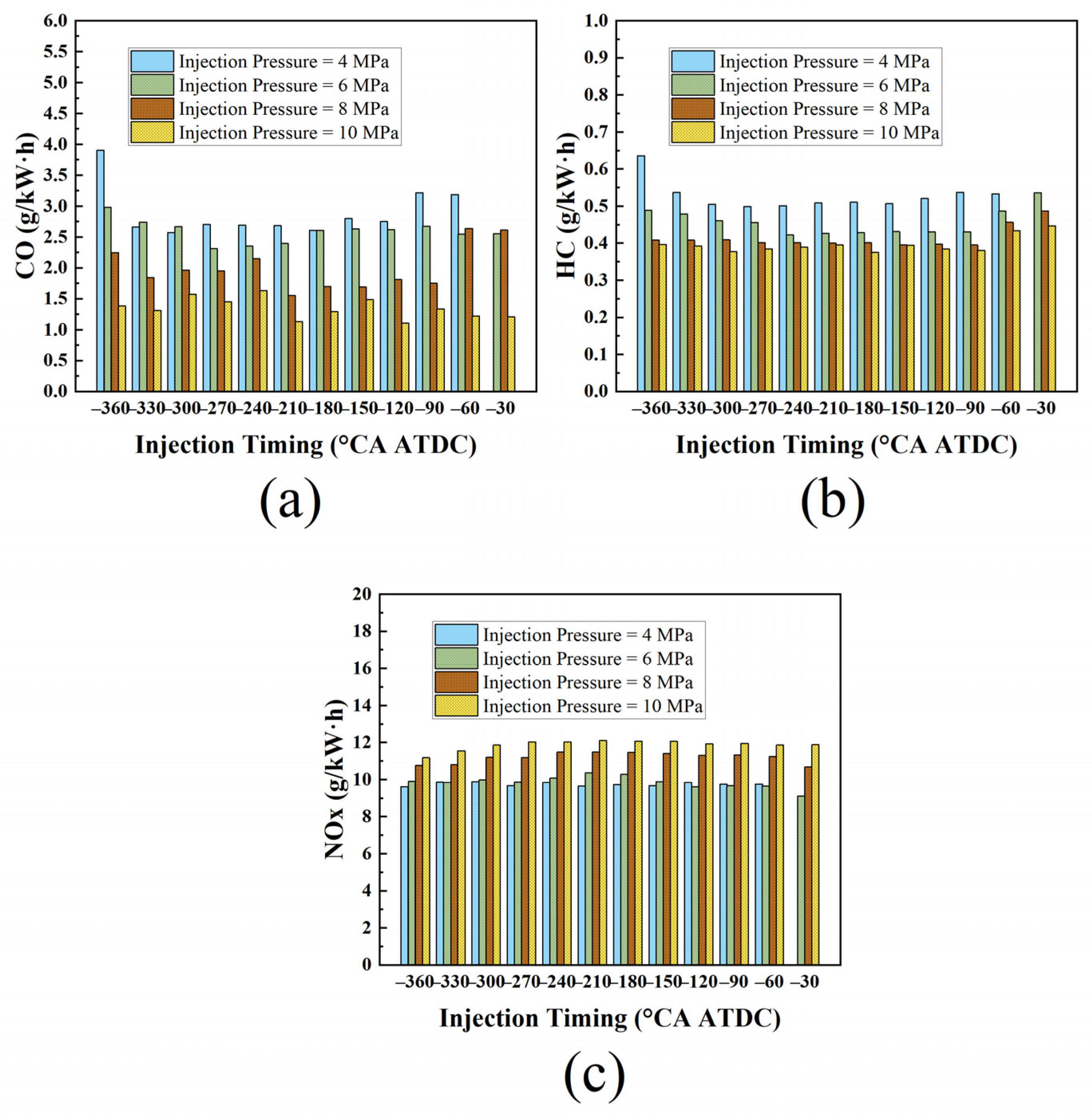
| Engine Parameters | Specifications |
|---|---|
| Engine type | In-line 4-cylinder, turbocharged |
| Bore × stroke (mm) | 82.5 × 92.8 |
| Displacement (L) | 1.984 |
| Compression ratio | 9.6:1 |
| Maximum power | 137 kW (5500 rpm) |
| Maximum torque | 320 N·m (1400–4000 rpm) |
| Maximum direct pressure | 24 MPa |
| Fuel Properties | Gasoline | Methanol |
|---|---|---|
| Chemical formula | C4–C12 | CH3OH |
| Content of O (%) | 0 | 50 |
| RON | 92 | 110 |
| Density at 293 K (kg/m3) | 796 | 830 |
| Stoichiometric air–fuel ratio | 14.3 | 6.5 |
| Lower heating value (MJ/kg) | 43.5 | 19.7 |
| Latent heat of vaporization (kJ/kg) | 301.2 | 1109 |
| Laminar flame speed (m/s) | 0.38 | 0.523 |
| Parameters | Specifications |
|---|---|
| Injection pressure | 4, 6, 8, 10 MPa |
| Injection timing | −330~−30° CA ATDC (interval 30° CA) |
| Gasoline port fuel injection pressure | 305 kPa |
| Gasoline port fuel injection timing | −320° ATDC |
| Fuel injection mass ratio of PFI | 7.20 kg/h |
| Fuel injection mass ratio of DI | 0.72 kg/h |
| Intake air temperature °C | 42 °C |
| Intake air pressure | 120 kPa |
| Engine speed | 1500 rpm |
| Spark timing | −5° CA ATDC |
Disclaimer/Publisher’s Note: The statements, opinions and data contained in all publications are solely those of the individual author(s) and contributor(s) and not of MDPI and/or the editor(s). MDPI and/or the editor(s) disclaim responsibility for any injury to people or property resulting from any ideas, methods, instructions or products referred to in the content. |
© 2023 by the authors. Licensee MDPI, Basel, Switzerland. This article is an open access article distributed under the terms and conditions of the Creative Commons Attribution (CC BY) license (https://creativecommons.org/licenses/by/4.0/).
Share and Cite
Wang, J.; Tian, H.; Zhang, R.; Shen, B.; Su, Y.; Yu, H.; Zhang, Y. Experimental Investigation on the Effects of Direct Injection Timing on the Combustion, Performance and Emission Characteristics of Methanol/Gasoline Dual-Fuel Spark Turbocharged Ignition (DFSI) Engine with Different Injection Pressures under High Load. Energies 2023, 16, 7921. https://doi.org/10.3390/en16247921
Wang J, Tian H, Zhang R, Shen B, Su Y, Yu H, Zhang Y. Experimental Investigation on the Effects of Direct Injection Timing on the Combustion, Performance and Emission Characteristics of Methanol/Gasoline Dual-Fuel Spark Turbocharged Ignition (DFSI) Engine with Different Injection Pressures under High Load. Energies. 2023; 16(24):7921. https://doi.org/10.3390/en16247921
Chicago/Turabian StyleWang, Jun, Huayu Tian, Ran Zhang, Bo Shen, Yan Su, Hao Yu, and Yulin Zhang. 2023. "Experimental Investigation on the Effects of Direct Injection Timing on the Combustion, Performance and Emission Characteristics of Methanol/Gasoline Dual-Fuel Spark Turbocharged Ignition (DFSI) Engine with Different Injection Pressures under High Load" Energies 16, no. 24: 7921. https://doi.org/10.3390/en16247921
APA StyleWang, J., Tian, H., Zhang, R., Shen, B., Su, Y., Yu, H., & Zhang, Y. (2023). Experimental Investigation on the Effects of Direct Injection Timing on the Combustion, Performance and Emission Characteristics of Methanol/Gasoline Dual-Fuel Spark Turbocharged Ignition (DFSI) Engine with Different Injection Pressures under High Load. Energies, 16(24), 7921. https://doi.org/10.3390/en16247921





